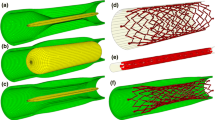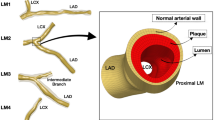Abstract
‘Stent versus stent’ studies are a kind of randomized trials which are designed to show the superiority of the new stent designs compared with the previously approved ones. These studies are usually used by regulatory agencies, such as the U.S. Food and Drug Administration (FDA), to give an approval to new stent designs. The problem with these clinical trials is their high cost and difficulty. In this paper, a numerical alternative for ‘stent versus stent’ complicated clinical studies is presented. A finite element model is developed to investigate the influence of stent design on the outcome after coronary stent placement. Two commercially available stents (the NIR and Multi-Link stents) are modeled and their behavior during the deployment is compared in terms of stress distribution, radial gain, outer diameter changes and foreshortening. Moreover, the effect of stent design on the restenosis rate is investigated by comparing the stress distribution within the arteries. An analysis of the arterial wall stresses in the stented arteries indicates that the Multi-Link stent design causes lower stress to an atherosclerotic vessel with a localized stenotic lesion compared to the slotted tube NIR design. The findings correlate with the observed clinical restenosis rates, which have reported higher restenosis rates in the NIR compared with the Multi-Link stent design.
Similar content being viewed by others
References
Imani, M., Goudarzi, A.M., Ganji, D.D. and Latif Aghili, A., The comprehensive finite element model for stenting: The influence of stent design on the outcome after coronary stent placement. J. Theor. Appl. Mech., 2013, 51: 639–648.
Pericevic, I., Lally, C., Toner, D. and Kelly, D.J., The influence of plaque composition on underlying arterial wall stress during stent expansion: The case of lesion-specific stents. Med. Eng. Phys., 2009, 31: 428–433.
Katritsis, D.G., Karvouni, E. and Ioannidis, J.P., Meta-analysis comparing drug-eluting stents with bare metal stents. Am. J. Cardiol., 2005, 95: 640–643.
Stettler, C., Wandel, S., Allemann, S., Kastrati, A., Morice, M.C., Schomiq, A., et al., Outcomes associated with drug-eluting and bare-metal stents: a collaborative network meta-analysis. Lancet., 2007, 370: 937–948.
Gu, L., Zhao, S., Muttyam, A.K. and Hammel, J.M., The relation between the arterial stress and restenosis rate after coronary stenting. J. Med. Devices, 2010, 4: 031005.
Eshghi, N., Hojjati, M.H., Imani, M. and Goudarzi, A.M., Finite element analysis of mechanical behaviors of coronary stent. Procedia Eng., 2011, 10: 3056–3061.
Baim, D.S., Cutlip, D.E., Midei, M., Linnemeier, T.J., Schreiber, T., Cox, D., et al., Final results of a randomized trial comparing the MULTI-LINK stent with the Palmaz-Schatz stent for narrowings in native coronary arteries. Am. J. Cardiol., 2001, 87: 157–162.
Kastrati, A., Dirschinger, J., Boekstegers, P., Elezi, S., Schuhlen, H., Pache, J., et al., Influence of stent design on 1-year outcome after coronary stent placement: A randomized comparison of five stent types in 1147 unselected patients. Catheter. Cardiovasc. Interv., 2000, 50: 290–297.
Kastrati, A., Mehilli, J., Dirschinger, J., Pache, J., Ulm, K., Schuhlen, H., et al., Restenosis after coronary placement of various stent types. Am. J. Cardiol., 2001, 87: 34–39.
Pache, J., Kastrati, A., Mehilli, J., Schuhlen, H., Dotzer, F., Hausleiter, J., et al., Intracoronary stenting and angiographic results: strut thickness effect on restenosis outcome (ISAR-STEREO-2) trial. J. Am. Coll. Cardiol., 2003, 41: 1283–1288.
Chua, S.N.D., MacDonald, B.J. and Hashmi, M.S.J., Finite-element simulation of stent expansion. J. Mater. Process. Technol., 2002, 120: 335–340.
Dumoulin, C. and Cochelin, B., Mechanical behaviour modelling of balloon-expandable stents. J. Biomech., 2000, 33: 1461–1470.
Gu, L., Santra, S., Mericle, R.A. and Kumar, A.V., Finite element analysis of covered microstents. J. Biomech., 2005, 38: 1221–1227.
Chua, S.N.D., MacDonald, B.J. and Hashmi, M.S.J., Effects of varying slotted tube (stent) geometry on its expansion behaviour using finite element method. J. Mater. Process. Technol., 2004, 155–156: 1764–1771.
Chua, S.N.D., MacDonald, B.J. and Hashmi, M.S.J., Finite element simulation of stent and balloon interaction. J. Mater. Process. Technol, 2003, 143–144: 591–597.
Xia, Z., Ju, F. and Sasaki, K., A general finite element analysis method for balloon expandable stents based on repeated unit cell (RUC) model. Finite Elem. Anal. Des., 2007, 43: 649–658.
Lally, C., Dolan, F. and Prendergast, P.J., Cardiovascular stent design and vessel stresses: a finite element analysis. J. Biomech., 2005, 38: 1574–1581.
Walke, W., Paszenda, Z. and Filipiak, J., Experimental and numerical biomechanical analysis of vascular stent. J. Mater. Process. Technol., 2005, 164–165: 1263–1268.
Imani, M., Simulation of mechanical behaviors of NIR stent in a stenotic artery using finite element method. World Appl. Sci. J., 2013, 22: 892–897.
Serruys, P.W. and Kutryk, M.J.B., Handbook of Coronary Stents, third ed., Martin Dunitz Ltd., London, 2000.
Prendergast, P.J., Lally, C., Daly, S., Reid, A.J., Lee, T.C., Quinn, D., et al., Analysis of prolapse in cardiovascular stents: a constitutive equation for vascular tissue and finite element modelling. ASME J Biomech Eng, 2003, 125: 692–699.
Mario, C.D. and Karvouni, E., The bigger, the better: true also for in-stent restenosis? Eur. Heart J., 2000, 21: 710–711.
Versaci, F., Gaspardone, A., Tomai, F., Crea, F., Chiariello, L. and Gioffre, P.A., A comparison of coronaryartery stenting with angioplasty for isolated stenosis of the proximal left anterior descending coronary artery. N. Engl J. Med., 1997, 336: 817–822..
Kobayashi, Y., J., Kobayashi, N., Reimers, B., Albiero, R., Vaghetti, M., et al., Comparison of immediate and follow-up results of the short and long NIR stent with the Palmaz-Schatz stent. Am. J. Cardiol., 1999, 84: 499–504.
Ju, F., Xia, Z. and Sasaki, K., On the finite element modelling of balloon-expandable stents. J. Mech. Behav. Biomed. Mater., 2008, 1: 86–95..
Author information
Authors and Affiliations
Corresponding author
Rights and permissions
About this article
Cite this article
Misagh Imani, S., Goudarzi, A.M., Valipour, P. et al. Application of Finite Element Method to Comparing the Nir Stent with the Multi-Link Stent for Narrowings in Coronary Arteries. Acta Mech. Solida Sin. 28, 605–612 (2015). https://doi.org/10.1016/S0894-9166(15)30053-7
Received:
Revised:
Published:
Issue Date:
DOI: https://doi.org/10.1016/S0894-9166(15)30053-7




